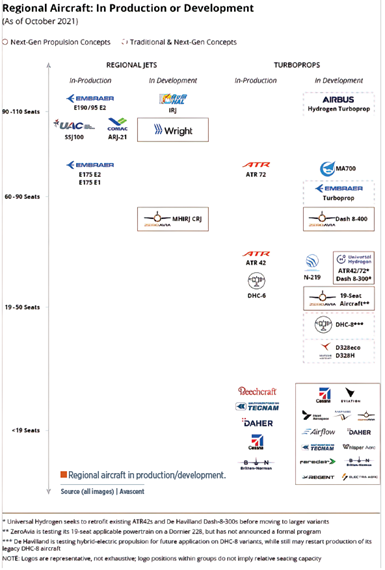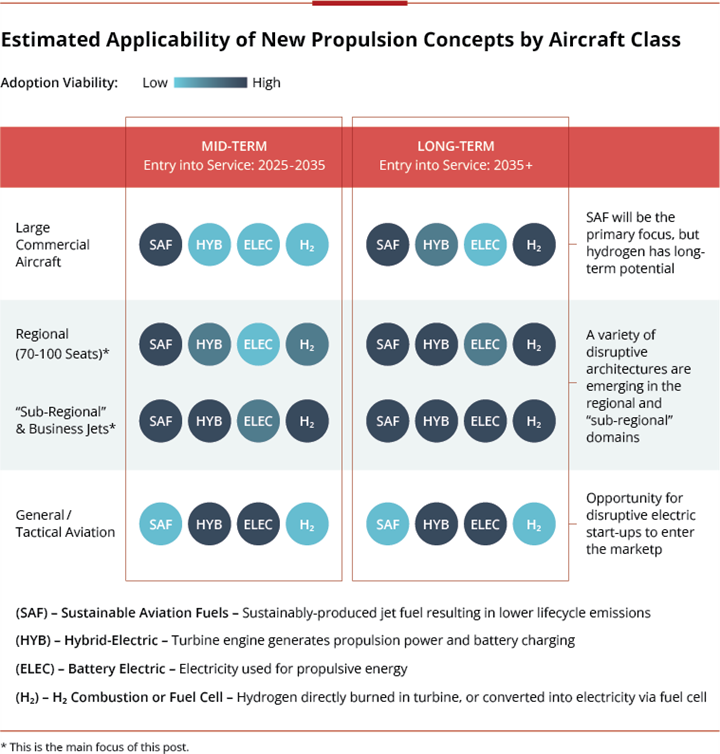Regional air mobility: A meaningful first step in the electric aviation revolution
Electrification of fixed-wing, <50-seat regional aircraft might stimulate a new era of growth that could help pave the way for advanced air mobility (AAM) aircraft.
Share
Read Next

Regional aircraft in production/development. Photo Credit, all images: Avascent
As commercial aerospace climbs out from the COVID-19 downturn, many suppliers, including various composites fabricators, have directed their attention to electric vertical takeoff and landing (eVTOL) aircraft that aim to ignite the advanced air mobility (AAM) market, sometimes also called urban air mobility (UAM).
Motivated by a long-term demand that some estimate could exceed $1 trillion, investors and corporations have funneled more than $7 billion into the AAM ecosystem since 20111. These funds have helped accelerate eVTOL demonstrators and certification progress, thereby justifying continued supplier attention.
But full realization of the AAM end-state depends on a range of technical, regulatory and cultural pieces all falling into place. This includes especially difficult aspects required for urban operations, such as high-density air traffic management and scaled vertiport infrastructure. Some eVTOL designs that depend on challenging transitions from vertical to horizontal flight may also face unforeseen market entry barriers.
Industry is undoubtedly well positioned to address these challenges over time. But in the background, suppliers should expand their focus to new regional aviation opportunities — both passenger and cargo — that are propelled by meaningful AAM enablers such as electric propulsion, yet are not constrained by the most difficult elements that may delay AAM’s full potential.
Regional air travel
Regional air travel is well suited to benefit from many of the building blocks needed for AAM. It plays a critical socioeconomic role in connecting remote markets with both passengers and goods and expanding mainline airline passenger flows. Yet fuel price increases have made regional operations increasingly unprofitable for smaller aircraft with limited capacity, forcing airlines to shift to larger aircraft or to just cancel service.
For instance, the number of unique routes flown in North America by commercial aircraft with less than 50 seats dropped 40% between 2005 and 20182.
Scott Kirby, CEO of United Airlines, said in July 2021, “We’re struggling with [how to serve small cities]; we feel some obligation to keep the communities connected, but the economics ultimately aren’t going to work… As the economics of 50-seaters are changing so radically, it calls into question what the answer is. And we don’t have the answer yet.”
In addition, just as airlines are questioning the viability of their regional networks, they are also reassessing their environmental footprint. In October 2021, the global airline industry committed to net-zero emissions by 2050. Actual implementation efforts will vary, but so far 20 operators, including Alaska Airlines, easyJet and Air New Zealand, have taken a first step by committing 30% of their short-range fleet after 2030 to next-gen aircraft. Others, like United Airlines and cargo airline DHL, have placed orders with regional eAircraft companies3. With 5,000 regional aircraft set to retire through 2035, there are plenty of positive demand signals.
To fully realize the benefits of electric propulsion, low-weight, high-performance composites will be critical. Newcomer Eviation (Qadima, Israel) and its all-electric, nine-seat Alice commuter aircraft, for example, which is poised for its first flight Q1 2022, is constructed with 95% composites. Others are expected to follow this design path to help offset battery system weight and drive improved aerodynamic efficiencies.
Amidst this promising outlook, the distinct evolution paths for larger and smaller regional aircraft will warrant close review.

Applicability of new propulsion concepts.
Large regional aircraft market dynamics (70+ seats)
Fuel costs have increasingly challenged the business case for large regional aircraft; the result is that just five regional aircraft are in production from two manufacturers, down from 13 types produced by eight OEMs 20 years ago.
Facing sales headwinds, Embraer (São Paulo, Brazil), one of the two remaining incumbents, is considering launching a modern turboprop that expects to generate much-needed 20% lower operating costs4 relative to existing options. It may eventually also offer emissions-free operations once hydrogen propulsion technology matures.
Other incumbents, such as ATR (Paris, France), De Havilland (Hatfield, U.K.) and MHIRJ (formerly Bombardier CRJ, Boisbriand, Canada) have also started exploring new options, though with less conviction around any one approach as they study emissions and cost trade-offs. Under consideration are hybrid battery electric, hydrogen fuel cells, direct hydrogen combustion and even dual-fuel kerosene/hydrogen combustion.
Small regional aircraft dynamics (<50 seats)
There is an exciting new demand opportunity for aircraft with less than 50 seats, should new propulsion systems deliver their promised performance improvements.
A 2016 NASA study concluded that as operating costs decline, 48 seats becomes the ideal capacity for regional operations — not only by optimizing profitability, but also by opening up more destination pairs and trip frequencies5.
Beyond this economic opportunity, smaller aircraft offer strategic benefit, too, as a way to cultivate new technologies before scaling to upmarket applications.
Propulsion retrofit approaches are common thus far — both hydrogen (e.g., Universal Hydrogen (Los Angeles, Calif., U.S.), ZeroAvia (Hollister, Calif., U.S.) and electric (Wright Electric (Los Angeles)) — while other plans are still not fully formalized. For example, De Havilland is considering hybrid and hydrogen systems, while Deutsche Aircraft (Oberpfaffenhofen, Germany.) is evaluating sustainable aviation fuel (SAF) and hydrogen.
Aircraft with less than 20 seats, now increasingly referred to as the “regional air mobility” or “sub-regional” landscape, are also gaining momentum.
The same 2016 NASA study concluded that should aircraft operating cost reductions exceed 40%, many more destination pairs can be served profitably on sub-20 seat aircraft.
Numerous first-mover concepts are based on conventional aircraft designs to enable easier certification (e.g., Eviation, Heart Aerospace (Göteborg, Sweden)). Other more novel concepts include short takeoff and landing (STOL) aircraft (e.g., Airflow (San Francisco, Calif., U.S.), Electra (Falls Church, Va., U.S.)) and even “seagliders” (e.g., Regent (Boston, Mass., U.S.)). eVTOL companies beginning to see the challenge in scaled urban operations are exploring regional passenger and cargo missions as well.
As validation of these startups’ ambitions, incumbent OEMs are investigating new concepts as well, including Embraer, Tecnam (Casoria, Italy), Cessna (Wichita, Kan., U.S.) and Britten-Norman (Bembridge, U.K.).
All competing aircraft still have much work ahead to prove that these paper drawings will meet the cost and performance targets in the field, but the groundswell of activity is a promising sign.
Key takeaways
Although many technical hurdles remain, the successful implementation of new propulsion technologies, supported by novel composite design and manufacturing, has the potential to revitalize regional route networks and position suppliers for longer term upmarket opportunities.
While promising, worsening pilot labor shortages will be a critical issue for entrepreneurs to contend with. Alongside necessary propulsion and composite airframe innovations, new flight deck technologies that can automate more tasks and safely improve single-pilot (or eventually remote pilot) commercial operations will likely become increasingly important for regional aviation as well as AAM.
As aircraft OEMs look to thread the needle between these economic, operational and environmental concerns, suppliers must begin evaluating how they can place smart bets on the underlying composite materials and manufacturing capabilities that will earn their way onto the inevitably wide range of winning aircraft architectures set to emerge over the next decade.
REFERENCES
1Crunchbase, company financial reports, Morgan Stanley, Avascent analysis
2Cirium, Avascent analysis
3World Economic Forum Target True Zero Announcement, November 2021
4Embraer estimates 20% improvement between its 90-seat variant and the ATR-72; The Air Current, November 2021
5Ty Marien, “Seat Capacity Selection for an Advanced Short-Haul Aircraft Design,” NASA Langley Research Center
About the Author
Jay Carmel
Jay Carmel is a senior director at Avascent and co-leads the Civil Aerospace consulting practice group. He supports manufacturers, service providers and financial sponsors with strategic growth planning, technology roadmapping and M&A due diligence in the commercial air transport, advanced air mobility (AAM) and business/general aviation end markets. jcarmel@avascent.com
Related Content
PEEK vs. PEKK vs. PAEK and continuous compression molding
Suppliers of thermoplastics and carbon fiber chime in regarding PEEK vs. PEKK, and now PAEK, as well as in-situ consolidation — the supply chain for thermoplastic tape composites continues to evolve.
Read MorePlant tour: Spirit AeroSystems, Belfast, Northern Ireland, U.K.
Purpose-built facility employs resin transfer infusion (RTI) and assembly technology to manufacture today’s composite A220 wings, and prepares for future new programs and production ramp-ups.
Read MorePlant tour: Joby Aviation, Marina, Calif., U.S.
As the advanced air mobility market begins to take shape, market leader Joby Aviation works to industrialize composites manufacturing for its first-generation, composites-intensive, all-electric air taxi.
Read MoreNext-generation airship design enabled by modern composites
LTA Research’s proof-of-concept Pathfinder 1 modernizes a fully rigid airship design with a largely carbon fiber composite frame. R&D has already begun on higher volume, more automated manufacturing for the future.
Read MoreRead Next
Plant tour: Daher Shap’in TechCenter and composites production plant, Saint-Aignan-de-Grandlieu, France
Co-located R&D and production advance OOA thermosets, thermoplastics, welding, recycling and digital technologies for faster processing and certification of lighter, more sustainable composites.
Read MoreAll-recycled, needle-punched nonwoven CFRP slashes carbon footprint of Formula 2 seat
Dallara and Tenowo collaborate to produce a race-ready Formula 2 seat using recycled carbon fiber, reducing CO2 emissions by 97.5% compared to virgin materials.
Read More“Structured air” TPS safeguards composite structures
Powered by an 85% air/15% pure polyimide aerogel, Blueshift’s novel material system protects structures during transient thermal events from -200°C to beyond 2400°C for rockets, battery boxes and more.
Read More






















